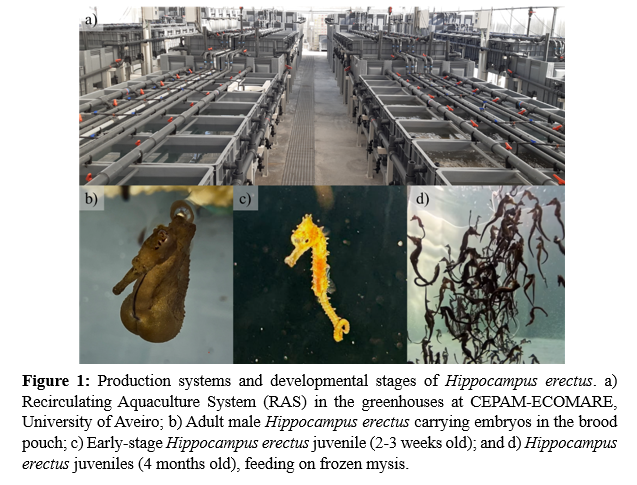ENHANCING SEAHORSE Hippocampus erectus PRODUCTION IN AQUACULTURE
Introduction
Seahorses are unique marine fish species renowned for their distinctive morphology and reproductive behaviour . Due to their high commercial value and conservation concerns, seahorse aquaculture has gained attention as a sustainable alternative to wild collection. However, the successful maintenance and cultivation of seahorses, especially during their early life stages, presents numerous challenges. This study at CEPAM-ECOMARE (University of Aveiro, Portugal) aims to investigate key factors in the rearing of seahorses, namely Hippocampus erectus , including water quality, food supply, and tank management, to improve survival and optimize commercial production.
Materials and Methods
The production of Hippocampus erectus at CEPAM-ECOMARE is performed in greenhouses , utilizing a 10,000 L Recirculating Aquaculture System (RAS). The seahorses are maintained in standard 200 L tanks, which are part of the RAS for efficient water circulation and optimal conditions for their growth and developmen t. These tanks are equipped with aeration and water flow to create circular currents that enhance the distribution of Artemia sp. and prevent biofilm buildup. Tanks are cleaned regularly, with a standard disinfection protocol every 15 days or following abnormal mortality events. Water quality is monitored weekly , with natural seawater sourced from the adjacent coastal lagoon Ria de Aveiro (Portugal) . For seahorse offspring , Artemia sp. metanauplii , enriched with omega-3 polyunsaturated fatty acids, particularly docosahexaenoic acid (DHA), are provided as primary food source to support early-stage development. As seahorses transition to juvenile and adult stages, they are gradually weaned onto frozen mysids (collected from the adjacent coastal lagoon ), with commercial-size adults being fed with commercial frozen mysis. S eahorse offspring are placed in a single tank , and the size
sorting process begins after the 80th day to optimize population distribution.
Results
Throughout the 7 -month study, 18 hatching events occurred from two breeding pairs, resulting in a total of 2,942 newly born seahorses. From these, 11 batches of Hippocampus erectus were reared up to 80 days post-hatching, with survival ranging from 63% to 98%. The average survival across all batches was 88%, indicating a strong success in early-stage rearing. Mortality did not follow a consistent pattern, with large periods of no mortality followed by occasional mortality events. These results are particularly promising given the typically low survival associated with early-stage seahorse rearing, which is often under 30%. After hatching , seahorses are kept at a maximum population density of 1.5 individuals per L. After the 80th day, sorting is carried out to control the population density, ensuring it does not exceed one seahorse per L . Once seahorses reach an adult size (> 60 mm in total length) , density is reduced to one seahorse per 2 L.
Discussion
The high survival achieved in Hippocampus erectus aquaculture can be explained by the use of natural seawater, which, unlike what is commonly reported, did not result in significant health issues. As such , the composition of natural seawater may be more suitable than artificial seawater when it comes to seahorse production . Additionally, the management of food supply, particularly Artemia sp. metanauplii enriched in DHA , proved essential to support the early-stage development of seahorse offspring. The success of the simple tank system, with modifications concerning aeration and water flow, further suggests that advanced seahorse offspring rearing tanks may not be necessary to successfully culture this seahorse species . P opulation management, namely through size
sorting , helped to maintain stability in the tanks and a stress-free environment. Overall, these results highlight the importance of managing population density for successful seahorse rearing.
Conclusion
The rearing of Hippocampus erectus has provided valuable insights into effective aquaculture practices, which are worth being tested with other seahorse species . The high survival recorded highlights the potential for commercial-scale production of seahorses, provided that key factors , such as food supply, water quality, and stocking density, are carefully managed. Future research will focus on optimizing these parameters for even larger-scale operations and explor e the potential of farmed seahorses for high-end uses.
Acknowledgements
This study was performed under the scope of project “BLUE BIOECONOMY PACT” (Project Nº. C644915664-00000026), co-funded by the Next Generation EU European Fund, under the incentive line “Agendas for Business Innovation” within Component 5—Capitalization and Business Innovation of the Portuguese Recovery and Resilience Plan (RRP)We also thank the financial support to UID Centro de Estudos do Ambiente e Mar (CESAM) + LA/P/0094/2020 through national funds.
